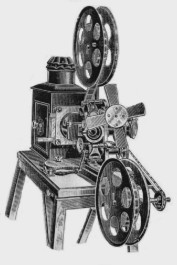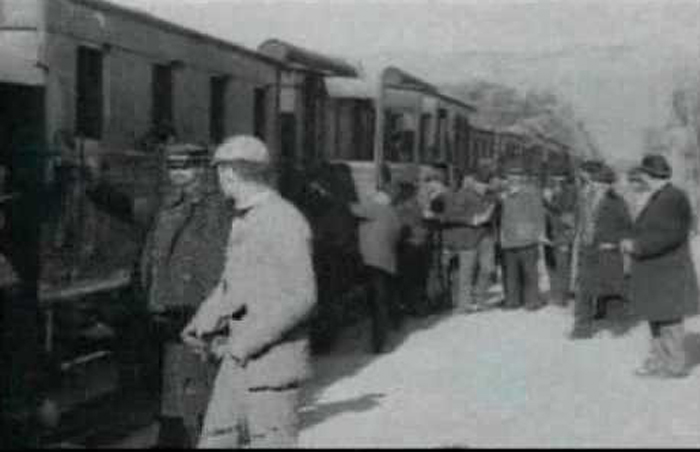 .
.
A view of life

The Bioscope
Charles Urban first made his name through the Bioscope projector. It proved so successful and popular an invention that it became a generic term for cinema itself. Its genesis is a little obscure, but its impact was immense.
Problems with the Vitascope
Urban had found problems exhibiting the electrically-driven Edison Vitascope projector in Michigan through 1896, where many towns were not yet connected to an electrical current, or the local supply was incompatible with the Vitascope, which required direct current. He was similarly frustrated by the limited capacity of the Vitascope, which could show only fifty foot rolls before the film had to be changed, causing delays in the programme. He made some crude adjustments, recalling "I had film reels constructed by using nine inch tin discs screwed to each end of an empty Clark's thread spool the centre hole of which was enlarged to fit the reel holder. This reel held about 750 feet of film". He cemented the films together with fish glue. This could only be a temporary solution, and he next went to a New York engineer of his acquaintance, Walter Isaacs, and instructed him to manufacture a projector that incorporated the take-up spool, plus a handle to free it from an electricity supply, and something to make it flickerless, flicker (caused by low projection speed and the use of single-blade shutters) being the chief complaint of all early film audiences.
In 1896, India was first exposed to motion pictures when the Lumiere Brothers' Chinematographe showed six soundless short films on July 7 in Bombay.
On 7th July 1896 (120 years ago), first cinema show was screened. Thanks to the Lumiere brothers who were French cinematographers, the screening of 6 films took place in Watson Hotel in Mumbai (then Bombay).

Can you guess the price of the tickets? It was Re 1! That’s right, it was just Re 1.
The Times Of India called this incident as the “Miracle Of The Century”.
Here’s the advertisement that appeared in the newspaper:
Filters

People also watched
Top 5 oldest Videos Ever Recorded - 1888?!
5.5M views5 years ago These are the oldest videos ever recorded and published. All of these videos were recorded by Thomas Edison, who invented ... 
3 chapters

Six films were screened that day – “Entry of Cinematographe”, “The Sea Bath”, “Arrival of a Train”, “A Demolition”, “Ladies and Soldiers on Wheels” and “Leaving the Factory”.

The second screening took place on July 14, 1896, at the Novelty Theatre, Bombay.
The motion pictures were then introduced in Kolkata and Chennai.
How does it make you feel that Indian cinema was screened on this date, 120 years ago!

access to the hotel. In retaliation he opened the Taj Hotel,
a hotel that stands near the Gateway of India, in 1903. However, author and historian Sharada Dwived idebunks this legend. She points out a lack of evidence to prove that Tata was a man of vengeance.

| The Lumière Brothers Les frères Lumière | |
|---|---|
|
Auguste Lumière (left) and Louis Lumière (right)
| |
| Place of birth | Besançon, France |
| Auguste | Auguste Marie Louis Nicolas Lumière
October 19, 1862
April 10, 1954 (aged 91) (Lyon, France) |
| Louis | Louis Jean Lumière
October 5, 1864
June 6, 1948 (aged 83) (Bandol, French Riviera) |
| Occupation | Filmmakers |
| Education | La Martiniere Lyon |
| Parents | Claude-Antoine Lumière (1840–1895) |
| Awards | Elliott Cresson Medal (1909) |
| Coordinates | |
|---|---|
| Structural system | Cast iron |
| Town | Mumbai |
| Country | India |
| Client | John Watson |
| Started | 1867 |
| Completed | 1869 |
| Architect | Rowland Mason Ordish |
| Engineer | Rowland Mason Ordish |
Edison kinetoscope films 1894 -1896
The Lumiere Brothers' - First films (1895)
l'arroseur arrosé:-FILM
The Frenchman Louis Lumiere is often credited as inventing the first motion picture camera in 1895. But in truth, several others had made similar inventions around the same time as Lumiere. What Lumiere invented was a portable motion-picture camera, film processing unit and projector called the Cinematographe, three functions covered in one invention.
|
Edison Kinetoscopic Record of a Sneeze, Jan. 7, 1894
- by LibraryOfCongress
- 4 years ago
- 334,687 views
The earliest surviving copyrighted motion picture, the Edison Kinetoscopic Record of a Sneeze is a short film made by W. K. L. ...-
Leonard-Cushing Fight
- by LibraryOfCongress
- 4 years ago
- 41,195 views
SUMMARY From Edison films catalog: An actual six-round contest between Mike Leonard, commonly called the "Beau Brummel" ... -
Edison Kinetoscopic Record of a Sneeze, 1894
- by TheEarlycinema
- 11 months ago
- 95 views
Check out our silent movie site. Complete with bios,filmographies and movies to watch http://theearlycinema.weebly.com. -
Sandow
- by LibraryOfCongress
- 4 years ago
- 97,001 views
SUMMARY According to vaudeville historian Joe Laurie, Jr., Sandow--who was managed by Flo Ziegfeld--was "the greatest of the ... -
Cinema 1894
-
0:26
Carmencita (Edison - Dickson - Heise - 1894)
-
0:04
Edison Kinetoscopic Record of a Sneeze / Fred Ott's Sneeze (Edison - Dickson - Heise - 1894)
View full playlist ( 25 videos)New York. Details Country: USA ... -
0:26
-
ONTSTAAN VAN FILM
View full playlist ( 5 videos)Bucking Bronco, filmed in 1894 by ...
Later in 1896, Edison showed his improved Vitascope projector and it was the first commercially, successful, projector in the U.S..
|


















No comments:
Post a Comment